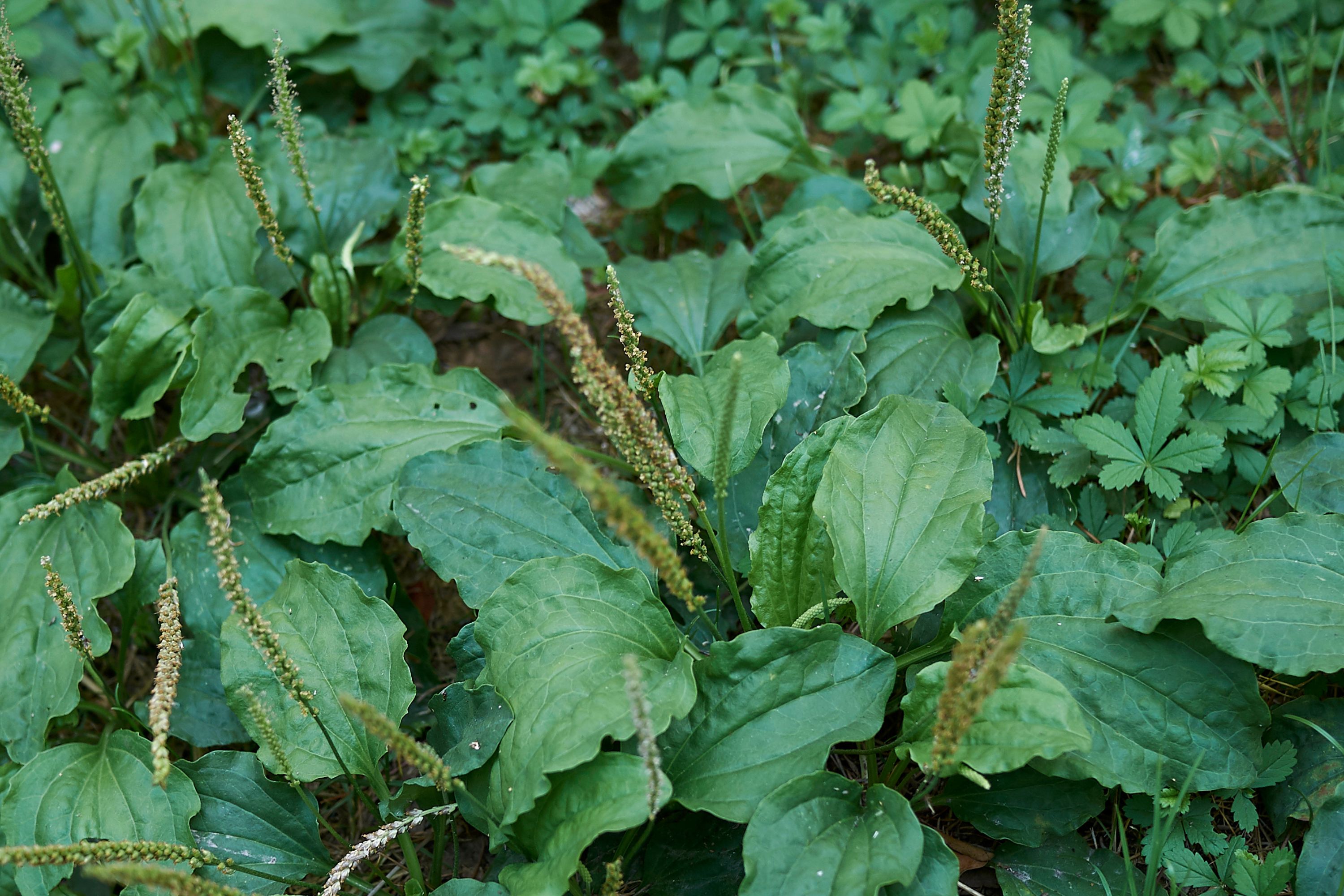Broadleaf plantain
(Plantago major)

Description
Plantago major, commonly known as broadleaf plantain or greater plantain, is a perennial plant native to Europe but now found in many parts of the world. It belongs to the family Plantaginaceae and is closely related to other members of the genus Plantago, including Plantago lanceolata and Plantago psyllium. Broadleaf plantain is a versatile plant that has been used for a variety of medicinal and culinary purposes for centuries. In this article, we will explore the various characteristics, uses, and benefits of this amazing plant. Taxonomy and Morphology Broadleaf plantain is a herbaceous perennial plant that can grow up to 50 cm tall. It has a rosette of basal leaves that are large, oval, and ribbed, with prominent veins that run parallel to the leaf edge. The leaves are arranged in a basal rosette and can grow up to 30 cm long and 20 cm wide. The stem is short, thick, and unbranched, and bears a cylindrical spike of greenish-brown flowers, which bloom from June to August. The plant has a fibrous root system, and its roots can grow up to 60 cm deep into the soil. The seeds of the plant are small, brown, and shiny, and can remain viable for up to five years. Distribution and Habitat Broadleaf plantain is native to Europe but is now widely distributed throughout the world. It can be found growing in a variety of habitats, including lawns, meadows, pastures, and disturbed areas such as roadsides and waste places. It is a hardy plant that can tolerate a wide range of soil types, but prefers moist, well-drained soils. Culinary Uses Broadleaf plantain has a long history of culinary use. The young leaves are edible and can be used in salads or cooked as a potherb. The leaves have a slightly bitter taste, but this can be reduced by blanching them in boiling water before cooking. The seeds can be dried, ground into a flour, and used as a thickener in soups and stews. Medicinal Uses Broadleaf plantain has been used for medicinal purposes for centuries. The plant contains a number of biologically active compounds, including iridoid glycosides, flavonoids, and tannins, which are responsible for its medicinal properties. The following are some of the medicinal uses of broadleaf plantain: Anti-inflammatory: Broadleaf plantain has anti-inflammatory properties and has been used to treat conditions such as arthritis, gout, and rheumatism. Wound Healing: The leaves of broadleaf plantain contain allantoin, which has been shown to promote wound healing and tissue regeneration. It is often used topically to treat cuts, bruises, and insect bites. Respiratory Infections: Broadleaf plantain has been used to treat respiratory infections such as bronchitis and coughs. It is thought to work by reducing inflammation in the respiratory tract. Digestive Issues: Broadleaf plantain has a mild laxative effect and has been used to treat constipation and other digestive issues. Anti-microbial: Broadleaf plantain has been shown to have anti-microbial properties, making it useful in the treatment of infections caused by bacteria and fungi. Immune System Support: Broadleaf plantain has been shown to have immune system-boosting properties, making it useful in the prevention of infections and other diseases. Urinary tract infections: The seeds of broadleaf plantain have been used traditionally to treat urinary tract infections and kidney stones. Common Uses In addition to its culinary and medicinal uses, Plantago major has a variety of other uses. Here are some of them: Animal feed: Plantago major is often used as a forage crop for livestock due to its high nutritional value. It is also a popular food source for wild animals such as rabbits, deer, and birds. Soil improvement: The deep roots of Plantago major help to break up compacted soil and improve soil structure, making it a useful plant for soil remediation and erosion control. Cosmetic and skincare: The anti-inflammatory and wound-healing properties of Plantago major make it a popular ingredient in cosmetic and skincare products, including creams, lotions, and balms. Dyeing: The leaves of Plantago major can be used to create a yellow-green dye for textiles. Beekeeping: The nectar of Plantago major is a food source for bees, and the plant can be used to increase honey production in beekeeping. Folklore: Plantago major has a long history of use in folklore and is associated with various superstitions and beliefs. For example, it was believed that carrying a sprig of Plantago major could ward off evil spirits, and that placing the leaves under the bed could protect against nightmares. Overall, Plantago major is a versatile and useful plant with a range of culinary, medicinal, and other uses. Its hardiness and adaptability make it a valuable plant for many different purposes, and its long history of use in traditional medicine and folklore is a testament to its effectiveness and importance.
Taxonomic tree:







